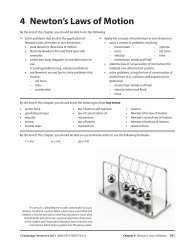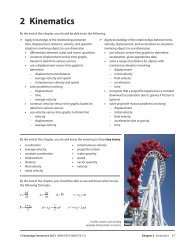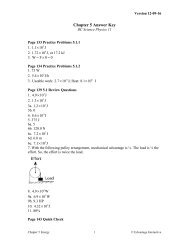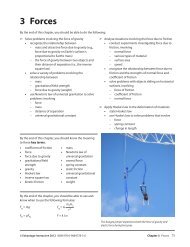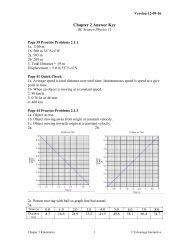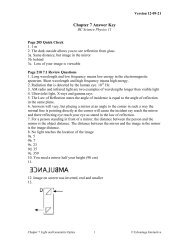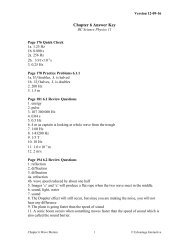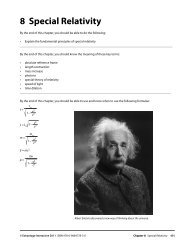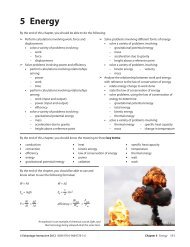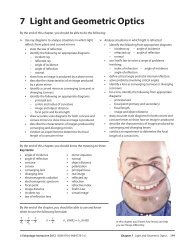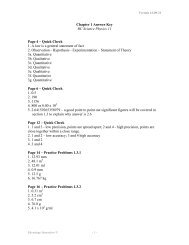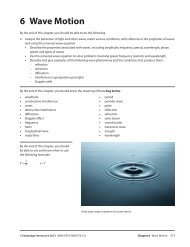1 Skills, Methods, and the Nature of Physics - BC Science Physics 11
1 Skills, Methods, and the Nature of Physics - BC Science Physics 11
1 Skills, Methods, and the Nature of Physics - BC Science Physics 11
You also want an ePaper? Increase the reach of your titles
YUMPU automatically turns print PDFs into web optimized ePapers that Google loves.
Converting Within<br />
<strong>the</strong> Metric System<br />
Table 1.4.1 SI Prefixes<br />
Prefix Symbol 10 n<br />
yotta Y 1024 zetta Z 1021 exa E 1018 peta P 1015 tera T 1012 giga G 109 mega M 106 kilo k 103 hecto h 102 deca da 101 deci d 10-1 centi c 10 –2<br />
milli m 10 –3<br />
micro µ 10 –6<br />
nano n 10 –9<br />
pico p 10 –12<br />
femto f 10 –15<br />
atto a 10 –18<br />
zepto z 10 –21<br />
yocto y 10 –24<br />
Assuming you know, or can access, <strong>the</strong>se equivalencies: 1 yard = 3 feet <strong>and</strong> 1 foot =<br />
12 inches, your approach would be as follows:<br />
1.00 yards ×<br />
3 feet<br />
1 yard<br />
× 12 inches<br />
1 foot<br />
© Edvantage Interactive 2012 ISBN 978-0-9864778-3-6 Chapter 1 <strong>Skills</strong>, <strong>Methods</strong>, <strong>and</strong> <strong>the</strong> <strong>Nature</strong> <strong>of</strong> <strong>Physics</strong> 21<br />
× 2.54 cm<br />
1 inch<br />
= 91.4 cm<br />
Notice that as with <strong>the</strong> multiplication <strong>of</strong> any fractions, it is possible to cancel<br />
anything that appears in both <strong>the</strong> numerator <strong>and</strong> <strong>the</strong> denominator. We’ve simply<br />
followed a numerator-to-denominator pattern to convert yards to feet to inches to cm.<br />
The number <strong>of</strong> feet in a yard <strong>and</strong> inches in a foot are defined values. They are<br />
not things we measured. Thus <strong>the</strong>y do not affect <strong>the</strong> number <strong>of</strong> significant digits in<br />
our answer. This will be <strong>the</strong> case for any conversion factor in which <strong>the</strong> numerator <strong>and</strong><br />
denominator are in <strong>the</strong> same system (both metric or both imperial). Interestingly enough,<br />
<strong>the</strong> BIPM has indicated that 2.54 cm will be exactly 1 inch. So it is <strong>the</strong> only multiplesystem<br />
conversion factor that will not influence <strong>the</strong> number <strong>of</strong> significant digits in <strong>the</strong><br />
answer to a calculation. As all three <strong>of</strong> <strong>the</strong> conversion factors we used are defined, only<br />
<strong>the</strong> original value <strong>of</strong> 1.00 yards influences <strong>the</strong> significant digits in our answer. Hence we<br />
round <strong>the</strong> answer to three sig digs.<br />
The metric system is based on powers <strong>of</strong> 10. The power <strong>of</strong> 10 is indicated by a simple<br />
prefix. Table 1.4.1 is a list <strong>of</strong> SI prefixes. Your teacher will indicate those that you need to<br />
commit to memory. You may wish to highlight <strong>the</strong>m.<br />
Metric conversions require ei<strong>the</strong>r one or two steps. You will recognize a onestep<br />
metric conversion by <strong>the</strong> presence <strong>of</strong> a base unit in <strong>the</strong> question. The common<br />
base units in <strong>the</strong> metric system are shown in Table 1.4.2.<br />
Table 1.4.2 Common Metric Base Units<br />
Measures Unit Name Symbol<br />
length metre m<br />
mass gram g<br />
volume litre L<br />
time second s<br />
One-step metric conversions involve a base unit (metres, litres, grams, or<br />
seconds) being converted to a prefixed unit or a prefixed unit being converted to a<br />
base unit.<br />
Two-step metric conversions require <strong>the</strong> use <strong>of</strong> two conversion factors. Two<br />
factors will be required any time <strong>the</strong>re are two prefixed units in <strong>the</strong> question. In a<br />
two-step metric conversion, you must always convert to <strong>the</strong> base unit first.



